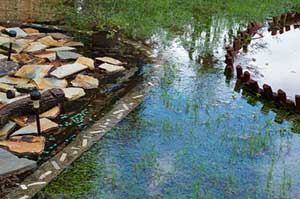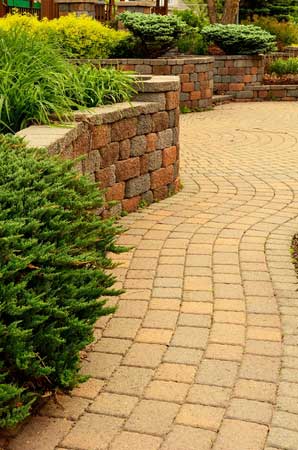With extreme weather events becoming more common, flooding has become a growing concern for many homeowners across the United States. In 2016 alone, the country faced 19 major flooding events, causing widespread damage to homes, landscapes, and infrastructure. If you live in an area prone to heavy rains and flooding, it’s essential to take proactive steps, such as building retaining walls, to protect your home is essential.
Preventative measures such as proper drainage, land grading, and the installation of retaining walls can help reduce the risk of floodwaters causing serious damage to your property. This guide will explore the detrimental effects of flooding, the role of retaining walls in flood prevention, and other landscaping techniques to help keep your home safe.
The Destructive Effects of Flooding on Your Home
Many homeowners underestimate the impact of flooding, assuming it will only affect carpets, furniture, and drywall. However, improper water drainage can lead to serious structural issues, including:
 Foundation Damage – Excess water weakens the foundation by softening the soil underneath your home, which can lead to cracks, uneven settling, and even complete failure of the foundation.
Foundation Damage – Excess water weakens the foundation by softening the soil underneath your home, which can lead to cracks, uneven settling, and even complete failure of the foundation.- Mold and Mildew Growth – Standing water can seep into walls, flooring, and insulation, creating ideal conditions for mold and mildew to thrive. Mold infestations not only damage materials but also pose serious health risks.
- Erosion of Soil – When water is not properly redirected, it can wash away soil, destroying your landscaping and increasing the risk of landslides or ground instability.
- Structural Decay – Water exposure accelerates the decay of wood, leading to rot and an increased chance of termite infestations.
To prevent these costly and time-consuming damages, investing in protective landscaping features, such as retaining walls, is a wise decision.
Retaining Walls: The Best Line of Defense Against Flooding
Retaining walls are one of the most effective solutions for mitigating flood damage. These specially constructed barriers hold back soil and prevent erosion, creating a sturdy boundary that redirects water away from your home.
How Retaining Walls Work
Retaining walls act as a barrier to manage the flow of rainwater and surface runoff. They are designed to:
- Hold back soil on sloped landscapes
- Direct water toward proper drainage channels
- Prevent soil erosion and landslides
- Protect your home’s foundation from excessive moisture
By strategically placing retaining walls around vulnerable areas of your property, you can redirect the flow of water away from critical structures, significantly reducing the risk of flooding.
Types of Retaining Walls
There are several types of retaining walls, each suited to different structural and aesthetic needs:
 Gravity Retaining Walls – These are built from heavy materials, such as stone or concrete, and rely on weight to resist pressure from soil and water. They are excellent for smaller landscaping projects.
Gravity Retaining Walls – These are built from heavy materials, such as stone or concrete, and rely on weight to resist pressure from soil and water. They are excellent for smaller landscaping projects.- Cantilevered Retaining Walls – Reinforced concrete walls with an extended base that helps distribute the weight of soil, making them ideal for areas with greater flood risks.
- Sheet Pile Retaining Walls – Made from steel, vinyl, or wood planks that are driven deep into the ground, these walls are used in areas with loose or water-saturated soils.
- Anchored Retaining Walls – Used for extreme conditions, these walls include additional anchors placed deep into the soil for added support.
Each type has its own advantages, and a professional retaining wall contractor can help determine the best solution for your yard.
Additional Landscaping Techniques to Prevent Flooding
While retaining walls play a vital role in flood prevention, they are most effective when combined with other landscaping techniques.
1. Proper Land Grading
Land grading, or reshaping the slope of your yard, is crucial in directing water flow away from your home. By adjusting the slope and ensuring that rainwater is guided toward appropriate runoff areas, you can minimize the risk of standing water and prevent flooding.
A professional grading contractor can assess your yard’s natural slopes and recommend changes to redirect rainwater safely.
2. Drainage Systems
Installing a drainage system can help carry excess water away from your home and prevent soil oversaturation. Some effective drainage solutions include:
French Drains: Underground pipes that direct water away from your foundation.
Trench Drains: Open trenches that collect surface water and divert it to safer runoff points.
Dry Wells: Deep underground wells that collect water and allow it to gradually absorb into the soil.
A combination of these systems with retaining walls can create an effective flood prevention strategy for your home.
3. Swales and Rain Gardens
A swale is a shallow, sloped channel that captures and directs water runoff. When integrated into landscaping, swales can help reduce surface flooding and prevent water from pooling in vulnerable areas.
Similarly, rain gardens use deep-rooted plants to absorb and filter rainwater. These gardens are aesthetically pleasing while serving the functional purpose of improving drainage.
4. Installing Permeable Paving
T raditional driveways and walkways can actually worsen flooding, as solid concrete and asphalt do not allow rainwater to be absorbed into the ground. Instead, consider using permeable paving materials, such as gravel, interlocking pavers, or permeable concrete, to allow water to soak into the soil naturally.
raditional driveways and walkways can actually worsen flooding, as solid concrete and asphalt do not allow rainwater to be absorbed into the ground. Instead, consider using permeable paving materials, such as gravel, interlocking pavers, or permeable concrete, to allow water to soak into the soil naturally.
5. Gutter and Downspout Management
Ensuring that rainwater is properly collected and drained away from your home is key. Gutter extensions and downspout diversions can prevent water from pooling near your foundation and help direct it toward designated drainage areas.
Hiring a Professional Retaining Wall Contractor
While some homeowners may attempt DIY flood prevention solutions, hiring a professional contractor ensures that the job is done correctly and effectively. A qualified retaining wall contractor will:
- Assess your property to determine the best flood prevention strategy
- Recommend suitable materials and construction techniques
- Ensure compliance with local building codes and regulations
- Provide quality workmanship that guarantees long-lasting results
Choosing the right contractor is crucial, as poorly built retaining walls and drainage systems can lead to long-term issues, such as wall failure or soil erosion. Be sure to select an experienced and reputable contractor to safeguard your home from future flood risks.
Reach Out to Our Trusted Retaining Wall Contractors
Flooding can be devastating, leading to foundation problems, mold growth, landscape erosion, and substantial repair costs. However, proactive measures such as retaining walls, proper grading, and effective drainage solutions can significantly reduce the risk of water damage to your home.
Investing in flood prevention now can save thousands of dollars in potential repairs down the road. If you are concerned about flooding on your property, consult a professional retaining wall contractor to discuss the best solution for your home.
By implementing the right landscaping and structural features, you can keep your house safe, dry, and secure in the face of extreme weather conditions.
For expert flood prevention solutions, contact Dirt Connections today to learn how our retaining wall and drainage services can help protect your home.








































